The Lost Giant Trees of West Gloucestershire
The Lost Giants
Very large trees in the Forest of Dean and surroundings have been sparse for centuries - fellings, spoliations and storms have all played their part. Pepys in his diaries documents “a great fall” in Edward III’s reign. Further major felling in the 16th and 17th centuries was largely due to the 72 iron forges working in the Dean, plus many furnaces requiring much charcoal. Storms also played a part, including one on 18th Feb 1662 which felled in one night 1000 oak and as many beech. Despite this, there remains a scattering of large trees – these are well documented by Chris Morris in his book “Dean’s Big Oaks and other species” Tanner’s Yard Press, 2007.
Below is some information about some of the significant trees which we know about, but which are now lost. Much of this information is available due to the diligent scholarship of Dr Cyril Hart OBE – erstwhile Head Verderer of the Forest of Dean and a great friend, who arranged and introduced a new edition of Nicholls’s Forest of Dean (David & Charles 1966) and made a major contribution with his own “Royal Forest” (Clarendon Press 1966).
JoY title
Jack of the Yat
Jack of the Yat
This large English Oak (Quercus robur) was located at the top of the Long Hill above Mireystock on the south side near Sallow Vallets Lodge. It was shown on a map ca 1682 and in 1818 it was considered to be the oldest tree in the Forest of Dean.
ET Machen considered it “most ancient” ca 4-500 years in 1858. A few years before it had been stuck by lightning, which had left a deep groove on its trunk. Machen as Deputy Surveyor had the tree measured regularly (at 6 feet above the ground)
1830 17’ 8 ¾”, 1838 17’9”, 1846 18’ 3 ½”, 1854 18’7 ¼
Bellows in 1881 speculated about the name, and concluded that Jack was derived from Yak for Oak, and Yat derived from Height (in Wales Allt). So - Oak of the Height. Interestingly, for such a notable tree, there is some confusion about its character. In Machen’s table of measurements, there is no mention of the form of the tree, though he does describe the double headed nature of the York Lodge tree. But in Nicholls (1858), the tree is shown as having two trunks seemingly coming from the same base – though the description in the book gives no hint of this, and neither does the sketch of the tree in Bellows in 1881, which is remarkably similar to the photo from 1906 published by Cyril Hart (see below).
By 1902 its girth was recorded as 19 feet. In 1913, A O Cooke described the tree thus “ Stag-headed as it is, old Jack o’ the Yat, which we shall find upon the roadside turf close to the lodge, is still a stately tree, measuring some two-and-twenty feet about the trunk. Growing close beside it is a second trunk only a little less in size. Whether both stems have sprung in some far distant century from the self-same stole, or whether each bole grew from a separate acorn is a point which has been argued; but probably the latter is the case. Nevertheless, the great root-arms of the trees have long since grown together on their adjacent sides, while each great trunk leans slightly from its neighbour as though in search of freer space for air and growth.
The late Thomas James of Mile End, Crown woodcutter, informed Cyril Hart that the tree was blown down in 1921. He heard it fall at about 6 am at the time when was cutting timber near the Strip-and-at-it Colliery. The tree fell towards Sallow Vallets Lodge. Richard Fox of Mile End cut it up. Percy Daniels, Crown forester, planted a tree in its stump. By 1952, however, all that was left was a rotting stump, but no replacement tree.
landmark on the roadside
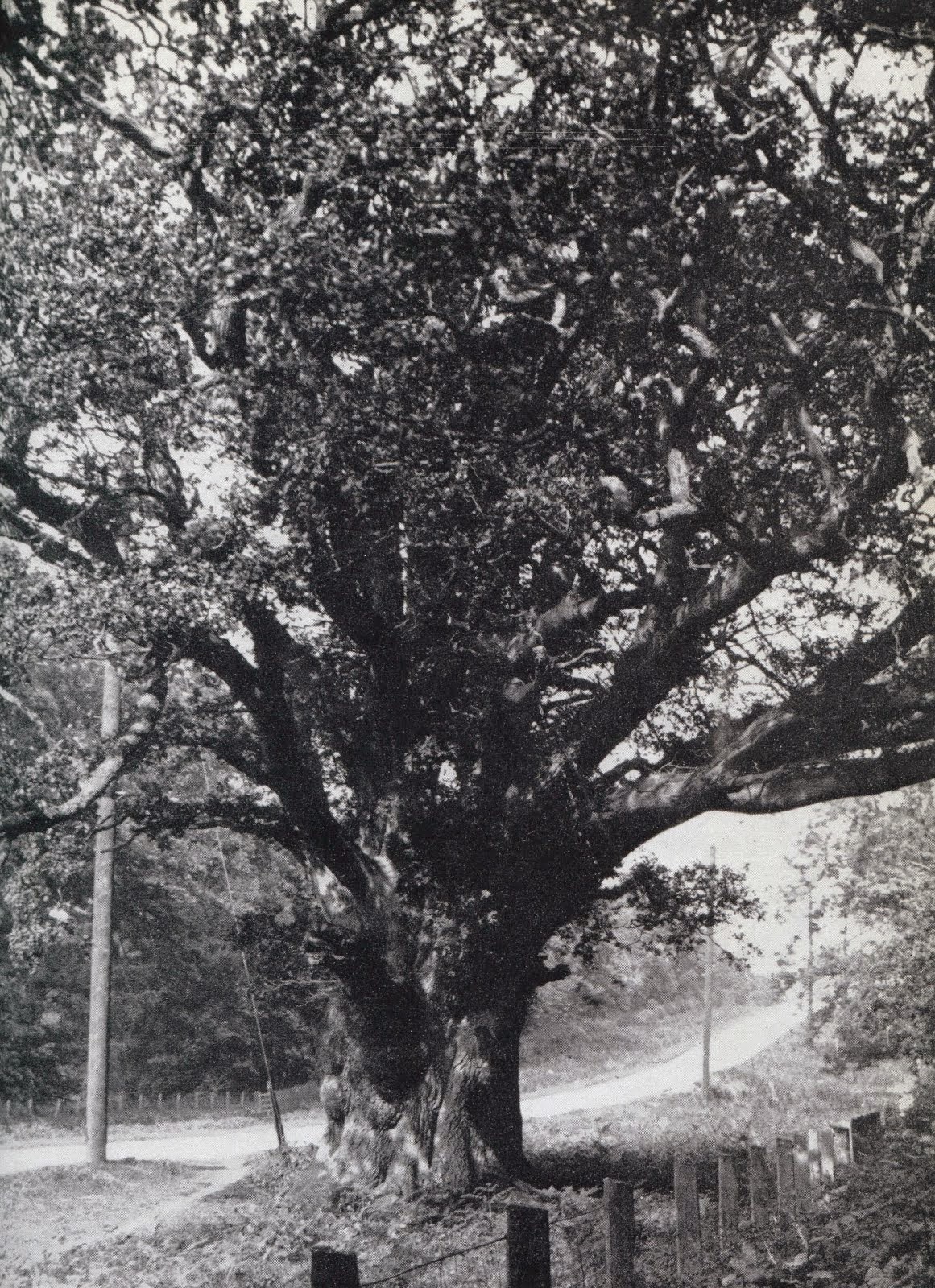
illustration from Nicholls
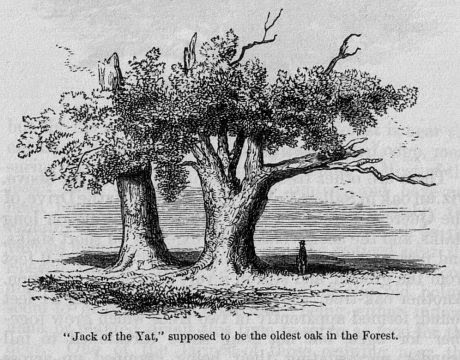
The High Beeches
Nicholls described five very fine large beech trees growing about two miles from Coleford on the road towards Mitcheldean in 1858. In May 1881, Bellows visited the trees which he said had no other large trees near them and were "distinguished from a great distance". The third was tallest and he measured it at 108 feet. In 1913 one tree was within the enclosure, the others by the roadside (of which one was broken and one had lost a big limb).
By 1952 most had collapsed and in ruins and only one healthy tree remained.
Today, the stump of one tree is still clearly visible from the road, whilst the rotting remnants of at least one other is located nearby.
high beeches in 1881
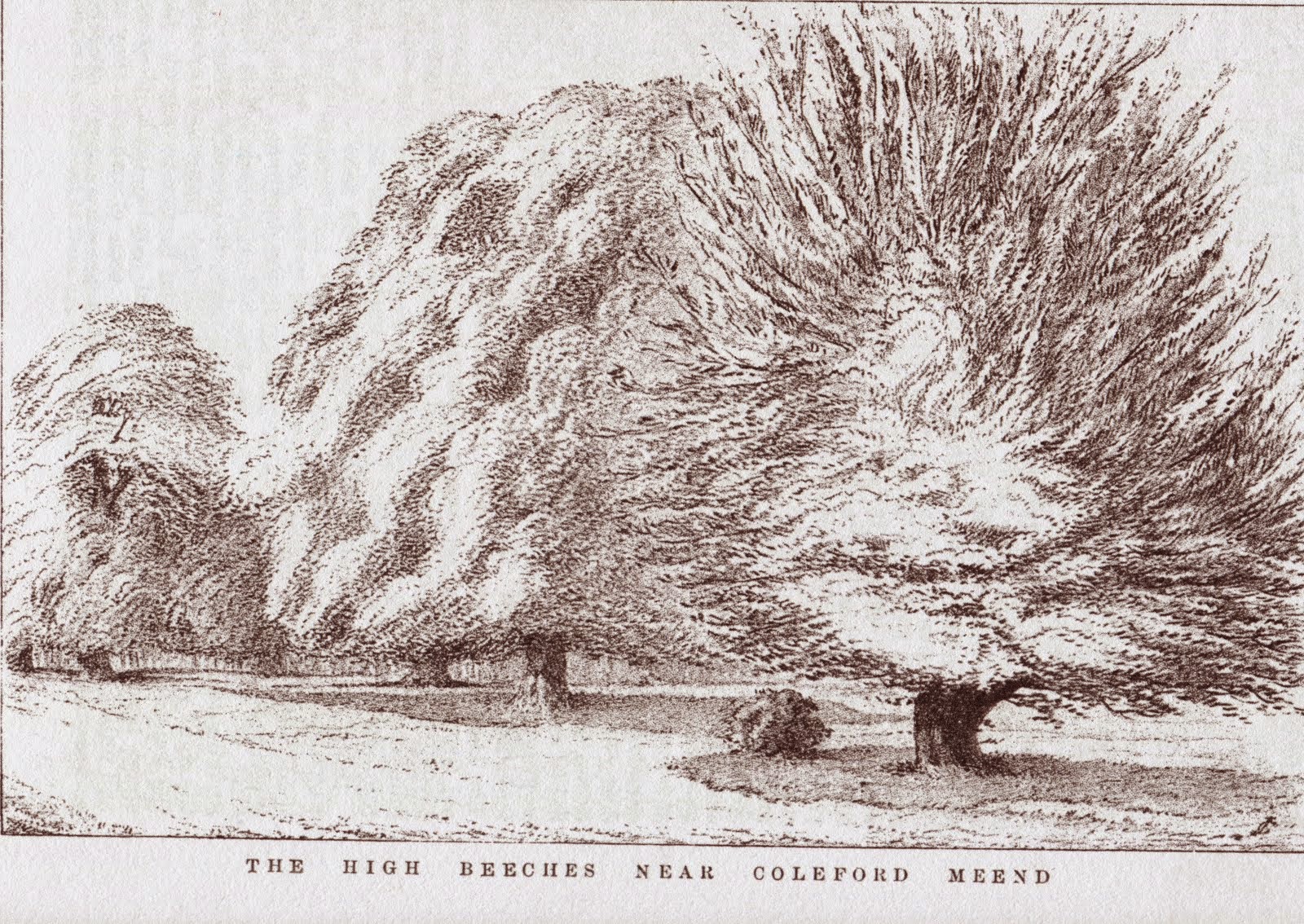
the beeches as sketched by Bellows in 1881
High Beech ca 1900
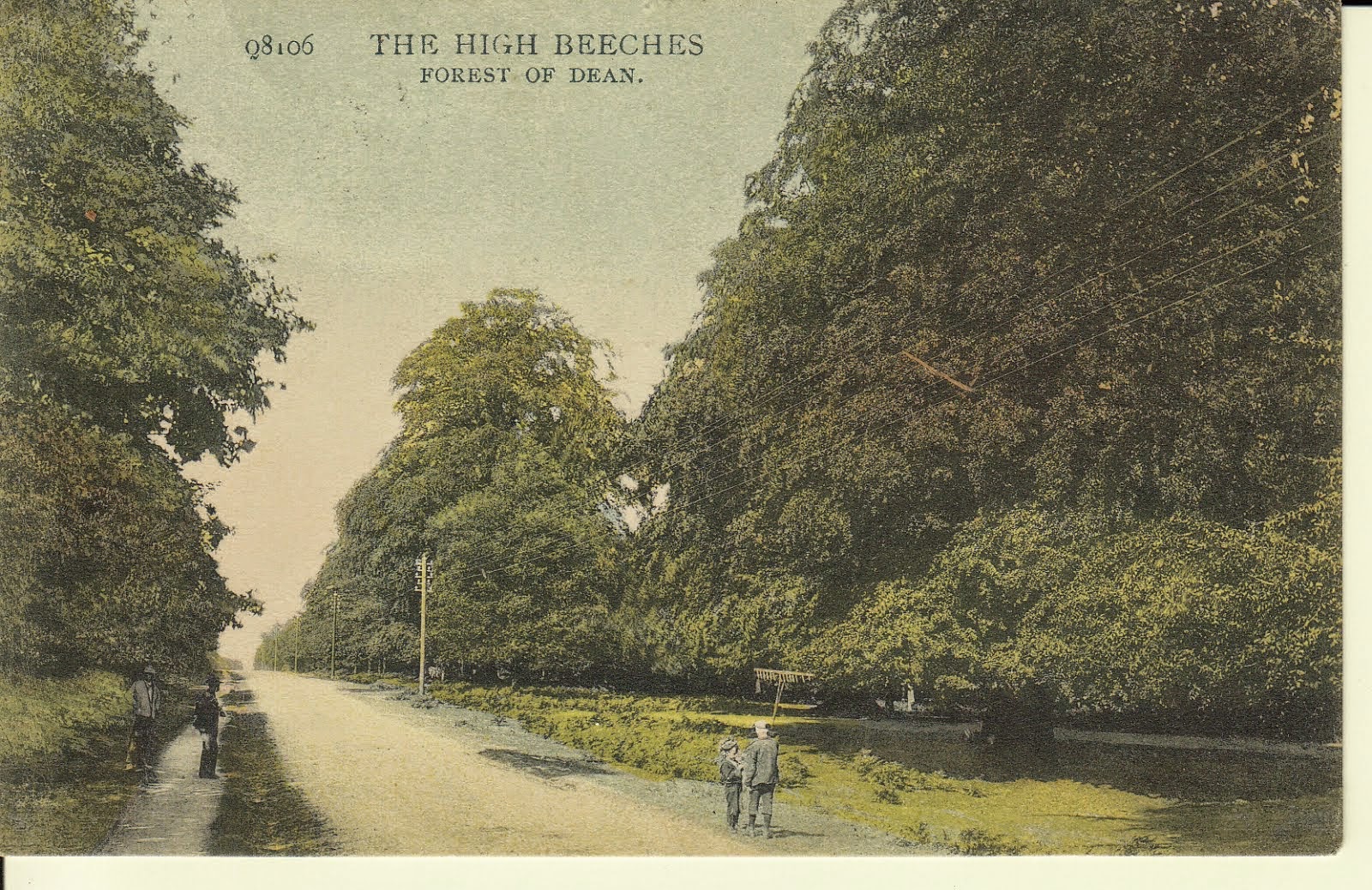
A postcard from ca 1900 (courtesy Ian Standing)
The surviving beech in the early 1950's

The surviving beech in the early 1950's
remaining stump in 2014
remaining stump in 2014
The Crad Oak
Cyril Hart considered that the Crad Oak was thought to be the last surviving oak in the Dean that predated the 1668 Dean Forest (Reafforestation) Act although Ian Standing notes that its size would suggest a planting date around 1682. Unlike most oak trees in the Dean, it was a pure sessile oak (Quercus petraea).
The Crad Oak was a feature of Vallet’s Wood for centuries, and there is evidence that it was preceded by similar notable trees. The first reference to a tree in this location is from 1282 to Kaderickes Oak (which is related to Caradoc, the Welsh for Caractacus). There is speculation that this may be linked to the Cradokstone near Sling. By 1608 there are references to a Carons Oak in this same area. Bellows (1881) noted that the tree towered above the rest and was called by some people "The King of the Forest" and by others "The Great Oak", "The Grey Oak" and "The White Oak".
In 1858, Nicholls described the tree as flourishing with a girth exceeding 13 feet measured six feet above the ground.
ET Machen, Deputy Surveyor, had arranged for the tree to be regularly measured during his time in charge of the Dean – his records are:
1830 12’ 4 ½ “, 1842 12’ 11 ½ “, 1848 13’ 4”, 1854 13’ 7 ½ “
In 188o, Bellows illustrated the tree in full foliage, and in 1888, the tree was described as “the best formed and most commanding” of trees in the Forest of Dean (Worth’s Tourists’ Guide to Gloucestershire). In 1913 its girth was recorded as 15feet 6 inches at 5 feet above the ground, in 1961, Cyril Hart measured it as 16 feet 8 inches, and in 1986, Ian Standing registered its decline with a irth of 16 feet 5 inches.
The decline of the tree was well recorded in photographs. On 17 July 1961 Dr Cyril Hart OBE was photographed beside the tree which was by then 16feet 8 inches at 5 feet. It had been struck by lightning on its north side a year or so earlier, and a hive of bees was in the north side of its base. The photograph appears as the frontispiece of “Royal Forest”. His later book “The Forest of Dean: New History 1550-1818” published in 1995 carried as its frontispiece another photograph of the author by the same tree the previous year with a comment that it was “now fast declining”. And Chris Morris’s book published in 2007 clearly showed the tree leaning and in decline.
The top was blown out of the tree during the stormy weekend of October 4-5th 2008 and the tree shattered at a point eight metres above the ground.
There are six saplings in a fenced enclosure adjacent to the tree which were intended to be successors to the Crad Oak, but of these, only one seems to be Q.petraea and this is suppressed with its top damaged.
Dr Cyril Hart OBE by the tree in 1961
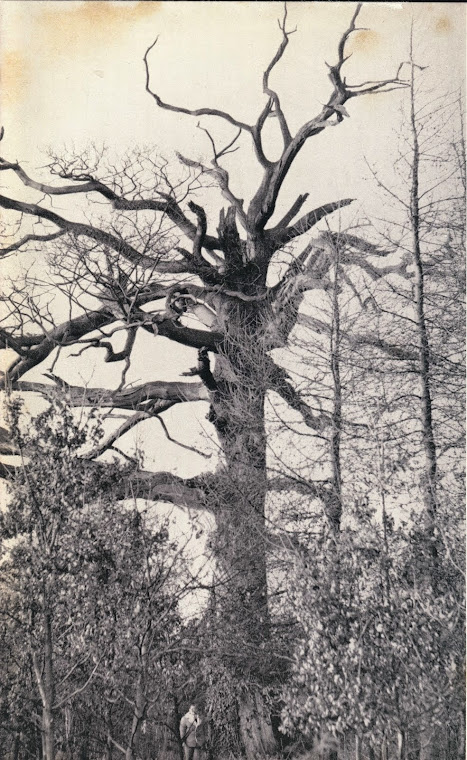
Dr Cyril Hart OBE by the tree in 1961
the Crad Oak in 1994
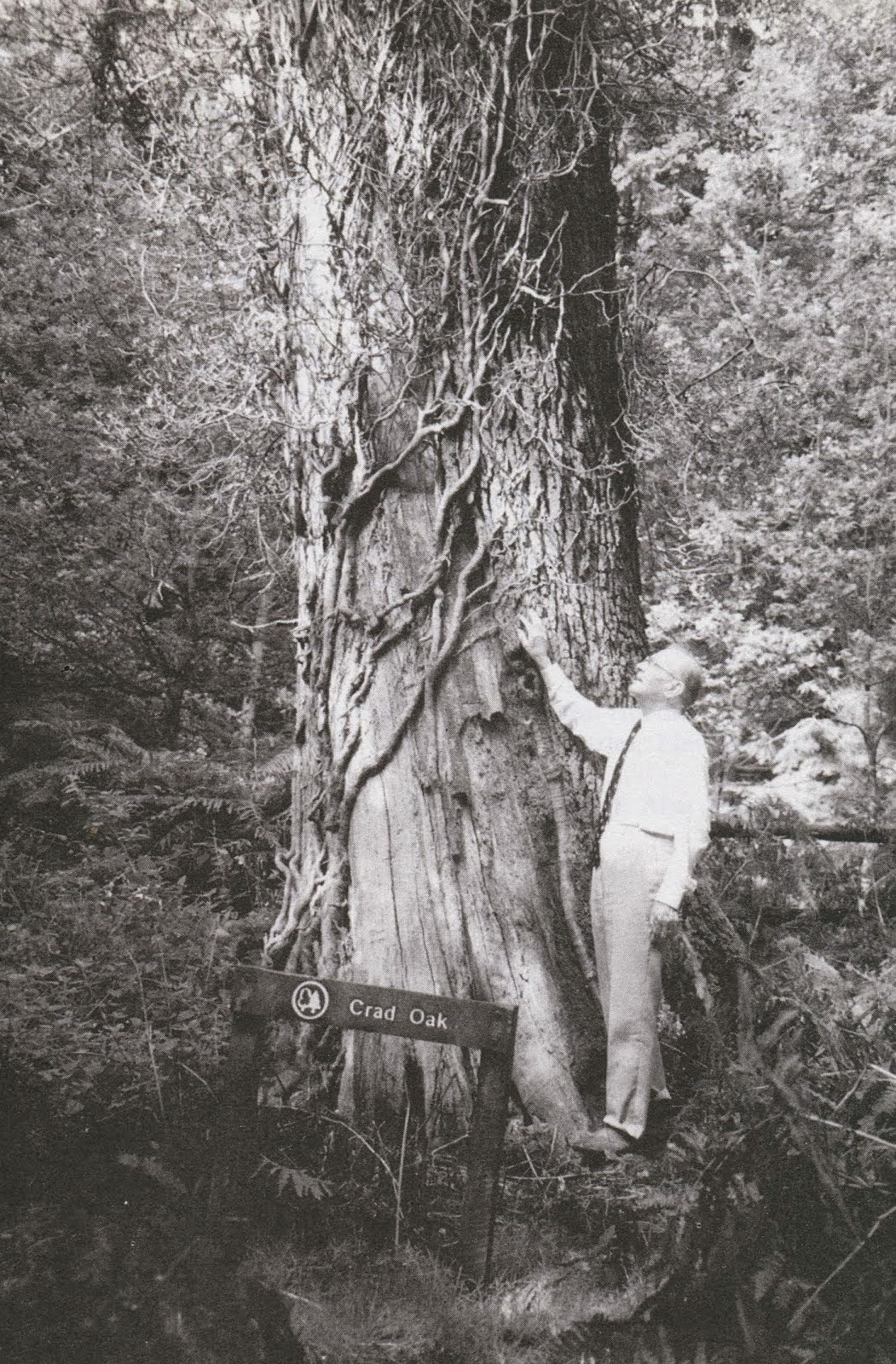
the Crad Oak in 1994
After the storm in 2008
After the storm in 2008
Machen Oak

The Machen Oak
The Machen Oak1

The Machen Oak in the late 20th C ( photo I Standing)
Machen Oak 2

The sad end of the Machen Oak in 2021
The York Lodge Oak
This was a striking tree. Nicholls wrote in 1858 “Another oak tree, near York Lodge, measured 21 feet round, formed apparently of two trees which grew together for ages, but not long since (actually in 1847) threatened to fall asunder, necessitating their being cramped up across the head by a transverse iron bar
ET Machen had the tree regularly measured over a period of ca 40 years.
1816 17’ 2”, 1826 18’ 9 ¾“, 1836 19’ 9”, 1846 21’0”, 1854 21’ 10”
The fate of the tree is unknown.
the only surviving image of the tree showing the brace
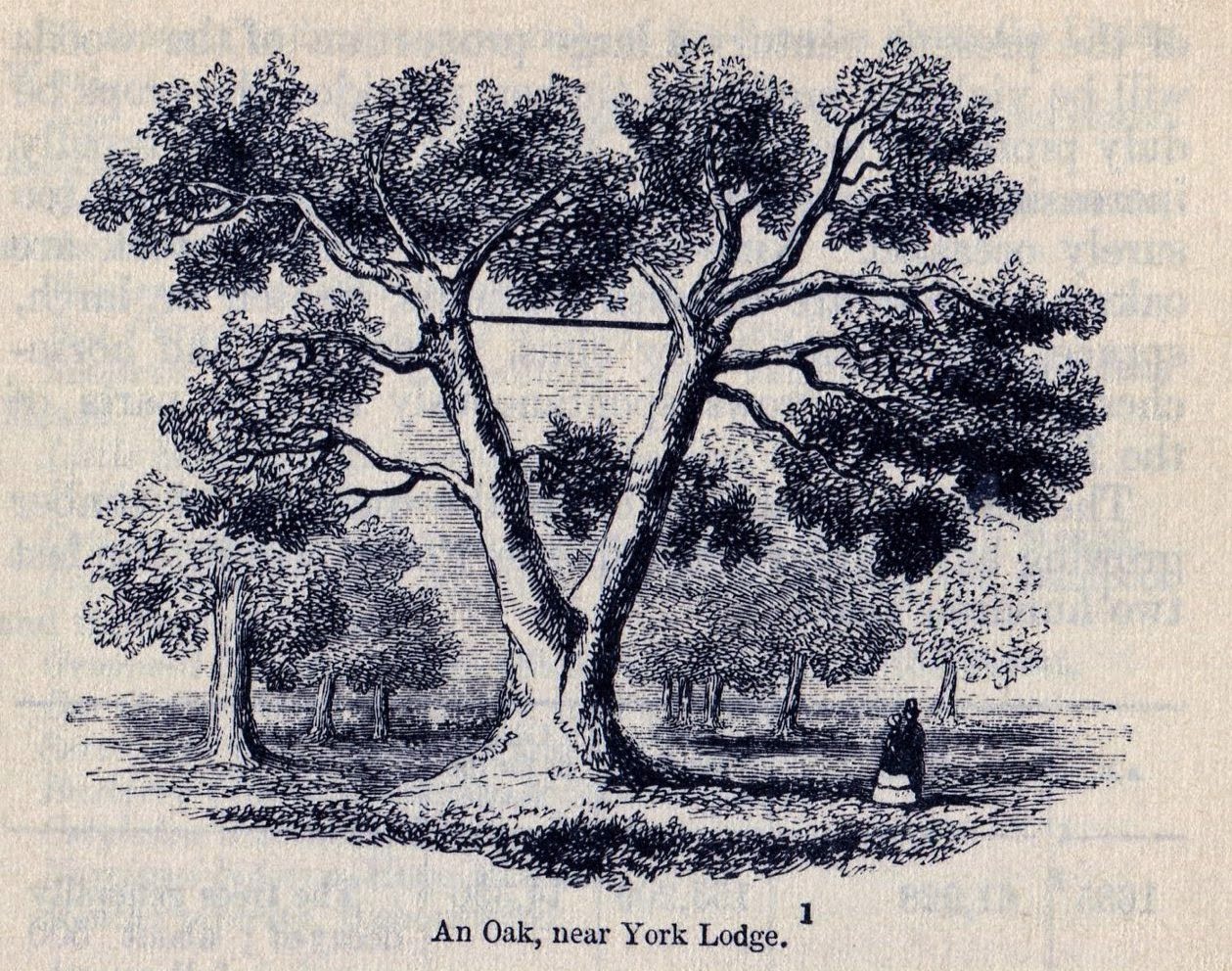
the only surviving image of the tree showing the brace
Parkend School Oak
This large tree was opposite Parkend school. A so-called Charles II oak, it was felled on November 15th 1968 when it was estimated to be 350 years old. At the time, its girth at the base was 31 feet. An interesting feature was that growing in the crown were saplings of hazel, beech, holly ash and elder. A slice from the stump was used by children of the school as a timeline and was exhibited at Beechenhurst in 1969 at the event to mark 50 years of the Forestry Commission.
The tree in 1961 with Anthony Hart
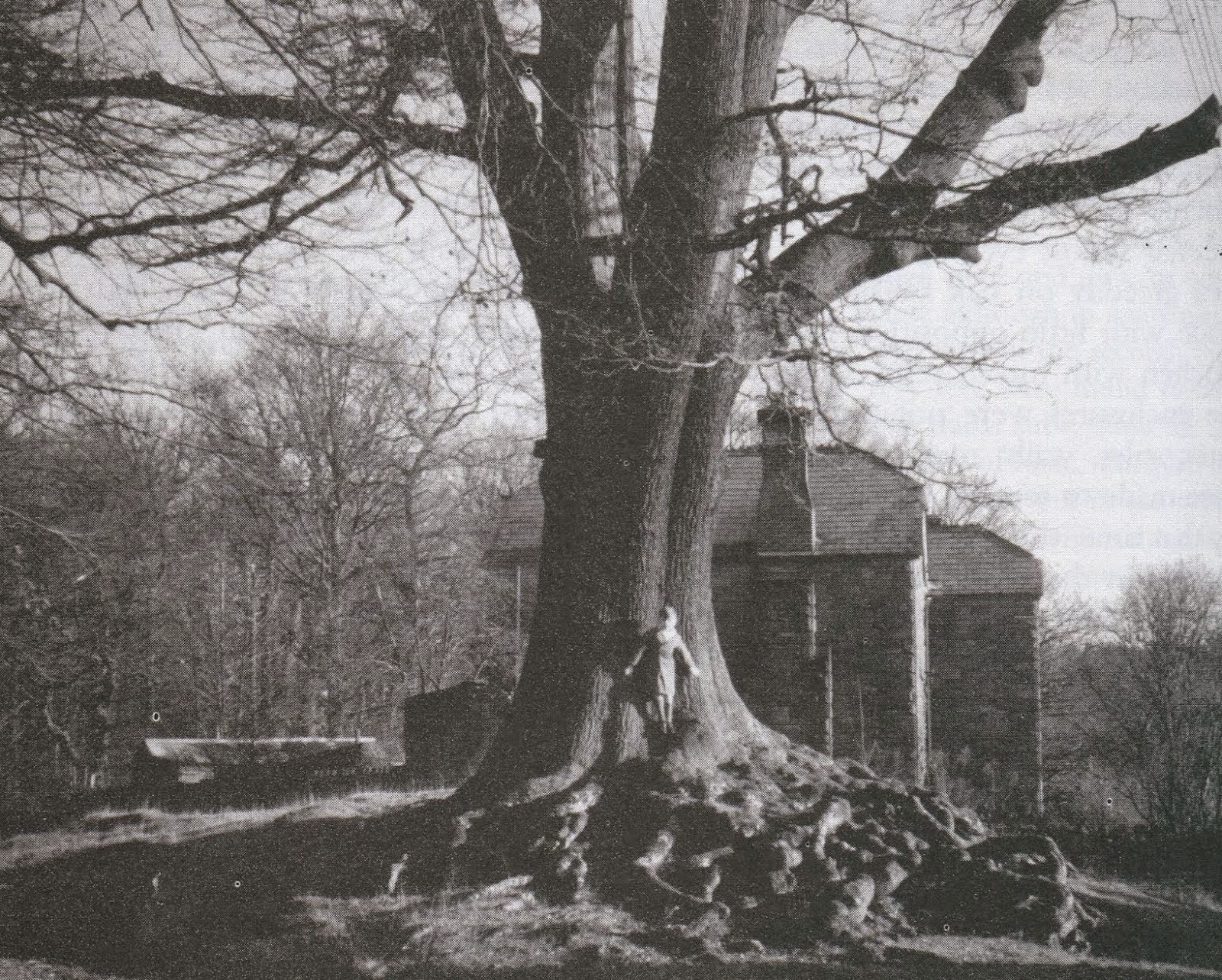
The tree in 1961 with Anthony Hart
Newland Oak
This famous tree was the largest English Oak (Quercus robur) ever recorded in Britain and with an estimated age of ca 1000 years, it was reputed to be the second oldest tree recorded in Britain (the oldest being a yew on Merrow Down, Guildford)
In 1858, Nicholls recorded its girth at 41 feet at 5 feet above the ground.
In 1899 it was measured as 40 feet 4 inches around the trunk which was about 12 feet up to the branches.
Cyril Hart’s mother played as a child within its hollow centre, so did a Dean lad who was to rise as Sir Arthur Gosling, to the position of Director-General of the Forestry Commission.
The earliest known photograph when the tree was quite healthy was from c. 1900 which clearly shows that it had been pollarded at some remote time in the past.
In 1906, Philip Baylis said the tree was a fine healthy pollard with a clean bole of some 12 feet in height. At its base it measured 45 feet 6 inches in circumference at 5 feet from the ground
The tree collapsed in a snowstorm in May 1955 but a live spur of its trunk still stood. This was then demolished in 1960. The remnants were burnt by vandals in 1970.
On 21st December 1964, Verderers Cyril Hart and John H Watts and Deputy Surveyor R G Sanzen-Baker planted three saplings produced from cuttings taken from the veteran tree. They were planted closely together, all three established successfully, and later the two smallest were removed. The replacement tree is still thriving in the midst of crops.
The history of the tree is also documented here
The tree in 1858
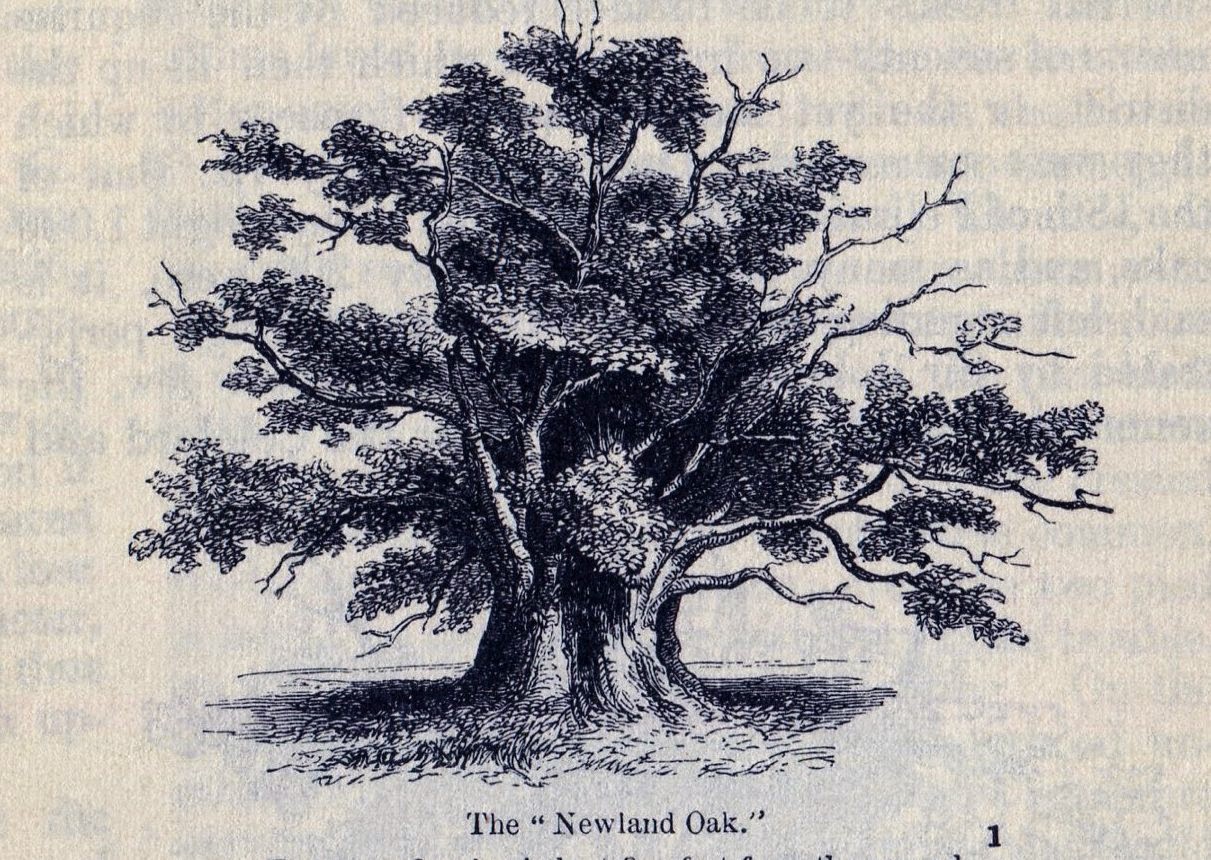
The tree in 1858
the first photograph

the first photograph
about 1950
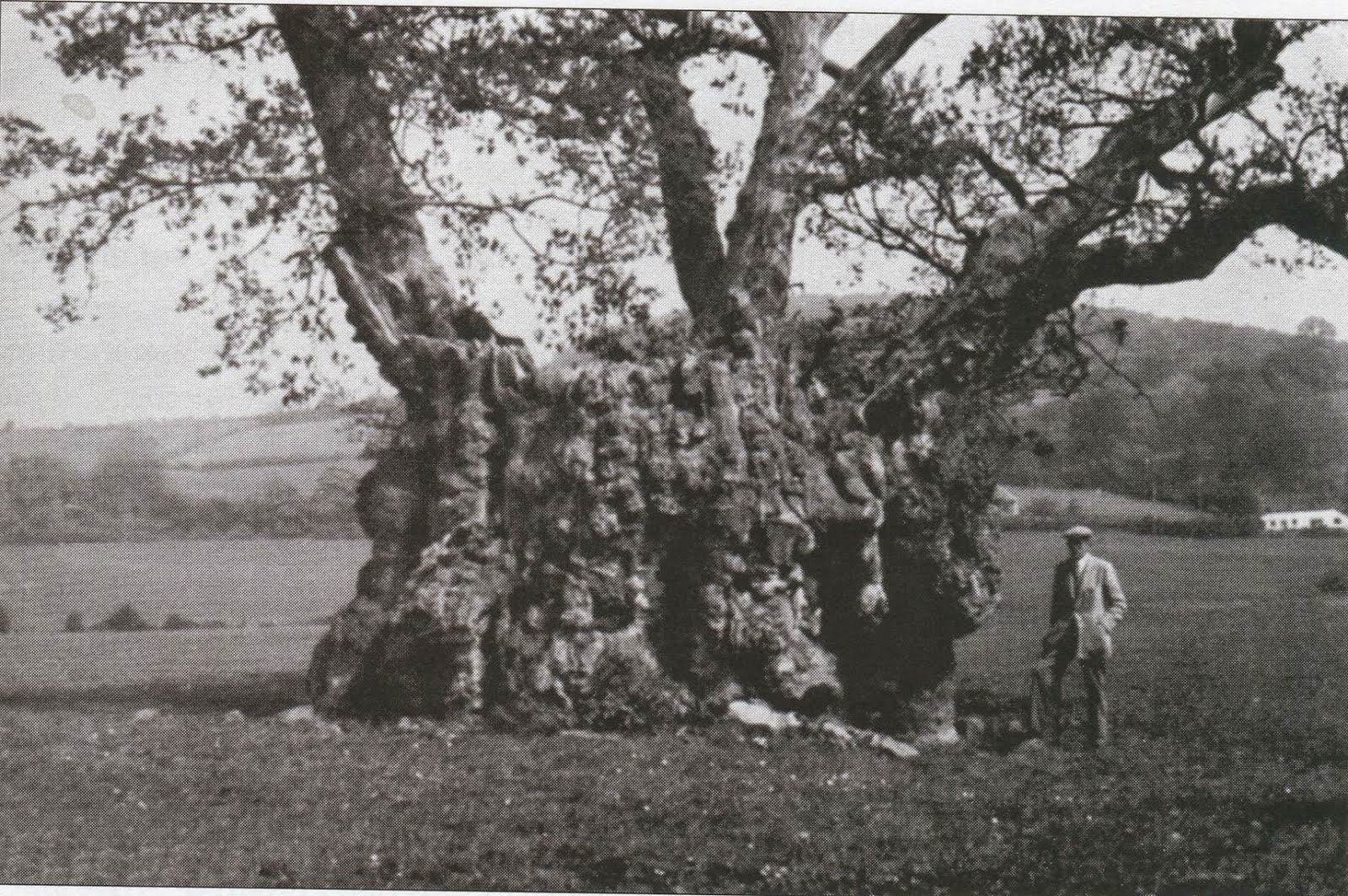
about 1950
Dr Cyril Hart OBE planting one of the replacement trees
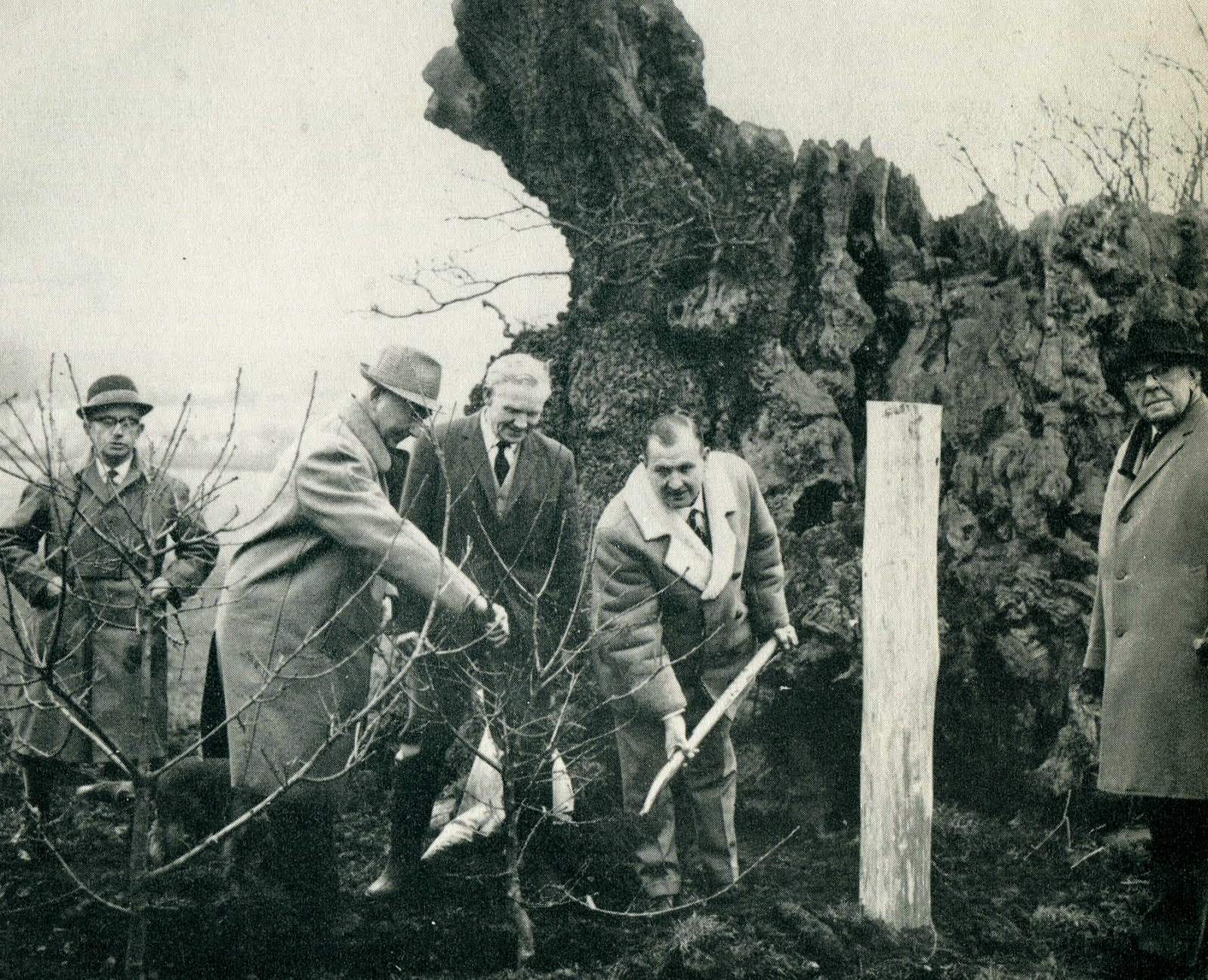
Dr Cyril Hart OBE planting one of the replacement trees
the replacement tree in 2014
the replacement tree in 2014
Lassington Oak
This big oak was located in Lassington Wood, above Highnam. Its location was shown on Taylors Map of Gloucestershire 1777.
In 1892, the tree was estimated to be 600 years old (C Witchell & WB Strugnell “The Fauna & Flora of Gloucestershire”) At that time, its girth was 29 feet but most of its branches were supported by props and a photo taken in 1907 also shows many limbs propped up with large timbers.
The tree was blown down in a gale in 1960.
Today, remnants of the tree lay strewn across the woodland floor, most easily seen in winter. It is still apparent that the trunk was some 10m high with significant branches reaching up to twice that height. The remains are regularly visited by members of the Lassington Oak Morris Men.
turn of the century
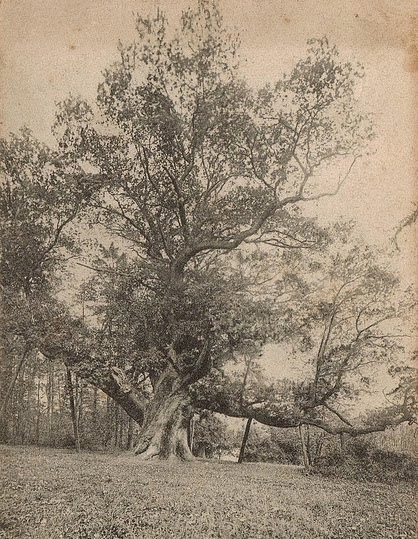
postcard from 1905
Lassington Oak 1902
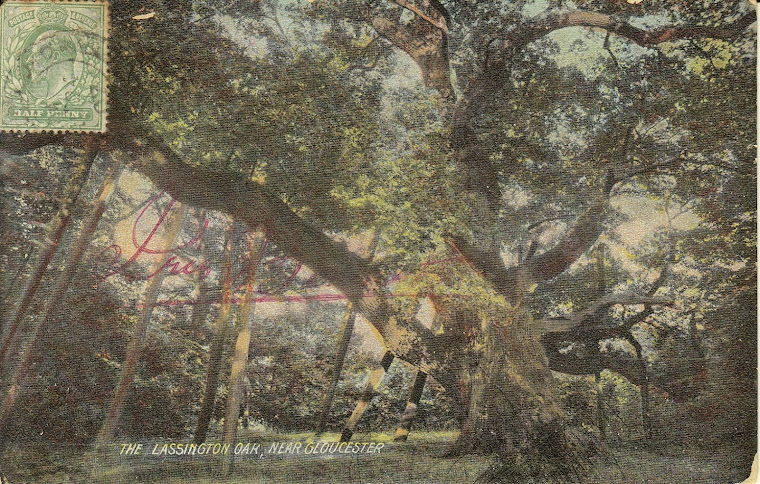
Postcard from ca 1902 (courtesy Ian Standing)
the remains today
Bill Taylor, past Squire and now Foreman of the Lassington Oak Morris Men with the remains of the tree
Others giants lost in the mists of time
Nicholls wrote in 1858 that there were two other oaks, similar in form to the Jack of the Yat, and fully as large in girth still existing, but in a decaying state, on Shapridge.
Nicholls also described some large beech trees on the Blaize Bailey almost as large as the High Beeches, besides several more near Danby Lodge, but he considered that the finest of all the beeches in the Forest was near the entrance to Whitemead Park, measuring 17 feet girth at 6 feet from the ground.
He also described the large hollies growing near Speech House, one a particularly big one, which he assumed had been planted about 1670 had a girth of 9 feet at 4 feet from the ground.